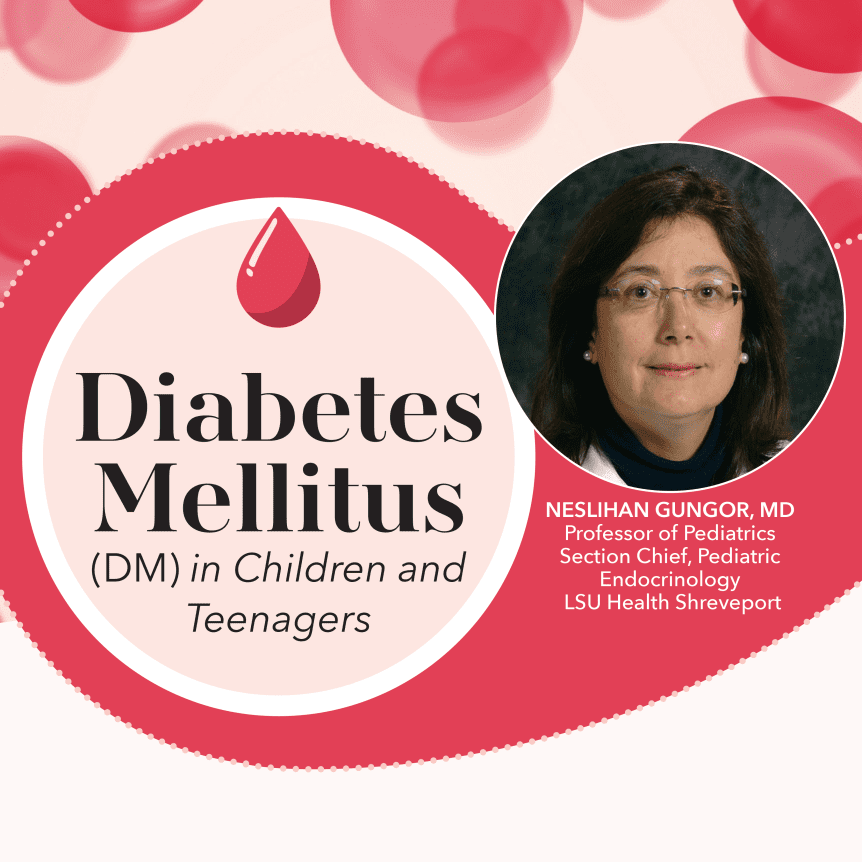Diabetes mellitus (DM) is a disorder in which blood sugar (glucose) levels are abnormally high.
A hormone called insulin controls the level of glucose in your blood. Diabetes mellitus is caused by either decreased insulin production (insulin deficiency) or decreased effect of insulin (insulin resistance).
There are different types of diabetes, Type 1 DM and Type 2DM, diabetes that occurs due to certain medications, and gestational diabetes (during pregnancy). The most common type of diabetes seen in children and adolescents is Type 1 Diabetes, which happens when your body does not make enough insulin. Type 2 Diabetes has also been on the rise, particularly in children 10 years of age or above. Type 2 DM is caused by resistance to insulin, when the insulin does not work well.
Insulin is a hormone released by the pancreas that helps control the amount of sugar in the blood. After eating food or drinking a beverage with calories in it, such as sugar-containing soda or milk, the digestion process in the stomach and intestines helps break these down into simple sugars, such as glucose, before they can be absorbed. Glucose is the main energy source for the body, and insulin allows glucose to move from the blood into the cells. Insulin acts like a key to open the inside of a cell, such as muscle, fat, or other cells, so that glucose can enter. This helps keep blood sugar in normal limits. A normal fasting blood sugar after an overnight fast (no food or caloric beverage consumption for 8-10 hours) is 70-100 mg/dl. Blood sugar is expected to go below 140 mg/dl in about two hours after food intake.
Without a proper amount of insulin or when the insulin does not work efficiently, sugar levels go up in the blood. This causes the sugar to appear in the urine. The sugar in the urine pulls more water into the urine, which results with increased urination (polyuria). The person loses more water in the urine, feels thirsty and drinks more (polydipsia).
How does diabetes come to attention in children and teens?
Signs of diabetes in children may be an increase in thirst and urination and/or sometimes bedwetting or accidents in a child who is toilet trained. Because sugar is wasted in the urine, one may have an increase in hunger and eat more. Despite plenty of extra sugar in the blood, the cells are unable to get this source of energy in, because of a lack of insulin. Tiredness and weight loss can also occur. If these symptoms are not noticed in reasonable time, additional problems follow such as dehydration or problems with other blood components including electrolytes, fat, and protein. The person going through this process may feel very sick and weak, get lethargic, have stomach pains, vomit, and start breathing rapidly. One may require a clinic or ER visit and even hospital admission. Children with diabetes may develop skin infections and/or yeast infections (in genital area) as well.
Type 1 Diabetes Mellitus
Type 1 diabetes is one of the most common, chronic childhood diseases. Type 1 DM is the most common type of diabetes seen in children and teens. It is a result of insufficient or no insulin production. In most children with Type 1 diabetes, the immune system mistakenly destroys the insulin producing beta cells in the pancreas. This is called an autoimmune process. When enough of these beta cells are destroyed the body cannot absorb the sugar it needs for energy and blood glucose rises to levels higher than normal.
The cause of Type 1 diabetes is a combination of genetic and environmental factors. Type 1 DM is an autoimmune condition, so the immune system attacks and destroys the insulin producing cells in the pancreas. This may be triggered by environmental factors, such as viruses, in people who have inherited certain genes that make them susceptible to developing diabetes. Close relatives of a person with Type 1 diabetes are at increased risk of developing diabetes. Type 1 DM is not contagious nor is it caused by eating sugar. More research is underway to find the exact causes of type 1 DM and how it can be prevented.
Type 2 Diabetes Mellitus
In Type 2 DM, your pancreas still makes insulin, but it does not work efficiently. This is called insulin resistance. The frequency of T2DM has increased in the childhood age group, particularly since 1990s. This has been parallel to increased rates of overweight conditions in children. Type 2DM is more commonly seen in Native American, African American, Mexican American, or Pacific Islander teens. Type 2 DM is most commonly diagnosed after puberty has begun (10-14 years of age). Children with the following conditions have higher risk of developing T2DM: overweight or obese; have a parent, sibling, aunt, uncle, or grandparent who has Type 2 diabetes; dark and thick skinfolds on the nape of the neck (acanthosis nigricans); physically inactive.
It is important to note that Type 2 diabetes is a progressive disease. Usually at onset, the pancreas can still make insulin but cannot make enough to overcome insulin resistance. Some children with Type 2 DM may be treated with pills to help increase insulin efficacy. However, some will need insulin treatment at the onset and/or at later stages of the disease. Recently new medications have become available for management of T2DM in teens. Treatment goals are similar to Type 1 DM, and healthy nutrition and daily physical activity are important components of the care plan.
In Conclusion
Advances in science and diabetes technology have improved the quality of life and control of blood sugar in individuals with diabetes. The availability of a variety of insulins/medications, practical devices for insulin administration (insulin pens, insulin pumps, pump and glucose monitor combinations) and devices to measure glucose (glucometers or continuous glucose sensors) make it easier to tailor the treatment to specific needs of each patient. The main goals of diabetes management are to keep blood glucose levels as close to the normal range as can be done safely, prevent additional health complications and allow for healthy growth and development. This can best be done when the child and caregiver are in close communication with their healthcare team and follow the care plan
carefully.
Treatment goals are to help the patient feel good and prevent/delay long term health problems by keeping blood sugars as close to normal as can be done safely. Prevention of weight loss and allowing for regular growth is of great importance in the care of children and teens.
To reach these goals, the patient must follow up regularly with a health-care team specializing in diabetes care. Caregiver/family collaboration is very important. The 4 key components of care plan are as follows:
- monitoring blood sugars using glucometers or continuous glucose monitors
- taking insulin: a variety of insulin types are available to help mimic the normal insulin production and action. Insulin can be taken with syringes, insulin pens or the help of insulin pumps.
- paying attention to nutrition: planning meals and snacks and choosing what, how much and when to eat
- being physically active
Neslihan Gungor, MD
Professor of Pediatrics
Section Chief, Pediatric Endocrinology
LSU Health Shreveport








